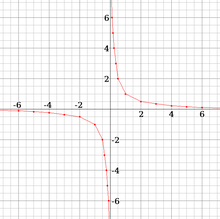Limit (mathematics) - Simple English Wikipedia, the free encyclopedia
In mathematics, a limit is the value that a function comes close to as the input comes close to some value.[1] When we use a function to solve a problem, sometimes certain values can not be used as inputs to the function, but we can see what the function comes close to when the input comes close to the value. Limits can be used to explain what happens in these cases.
Format
[change | change source]Limits are used to define many topics in calculus, like continuity, derivatives, and integrals.
For a function f, limit are written like this:
which reads "the limit of f of x, as x approaches c equals L". An alternative notation is " as ", which reads " tends to as tends to ". Limit is shortened to lim.[2][3]
For a sequence , the similar notation is used.[4]
Example
[change | change source]
Imagine we have a function that takes an input, , and then outputs to . If we were to draw a graph using x and y as coordinates, the results would look like this:
| x input | function | y output | x, y |
|---|---|---|---|
| 4 | 0.25 | 4, 0.25 | |
| 3 | 0.33 | 3, 0.33 | |
| 2 | 0.5 | 2, 0.5 | |
| 1 | 1 | 1, 1 | |
| 0 | undefined | 0, undefined |
As we can see here, division by zero is undefined. But if we look closer, then we can see that we still have valid output—as long as we never reach zero:
| x input | function | y output | x, y |
|---|---|---|---|
| 1 | 1 | 1, 1 | |
| 0.5 | 2 | 0.5, 2 | |
| 0.25 | 4 | 0.25, 4 | |
| 0.125 | 8 | 0.125, 8 | |
| -0.125 | -8 | -0.125, -8 | |
| -0.25 | -4 | -0.25, -4 | |
| -0.5 | -2 | -0.5, -2 | |
| -1 | -1 | -1, -1 |
This problem is unique to zero as the function still works on every value up to zero, even if we approach from the negative side. As input numbers get arbitrarily small, the output will simply get arbitrarily large, and if we draw this on a graph, the line will stretch upwards without bound before it touches 0 on either axis.
One way we describe this is "The limit of as approaches 0, from the right side, is ", meaning that can keep increasing beyond bounds, as long as x doesn't reach 0. Mathematically, this is written as: .
Applications
[change | change source]While a limit cannot be reached, it can be approached to get a more accurate output value. For example, the mathematical constant (Euler's number) can be found by calculating , where is an input:
| n input | function | output (e) |
|---|---|---|
| 1 | 2 | |
| 10 | 2.5937424601 | |
| 10,000 | 2.7182682372 | |
| 10,000,000 | 2.71828169398... |
While the equation will never be equal to , putting in a larger input will get us closer to it, and make our output more accurate. Mathematically, we can express this by saying that "The limit of as approaches is ", which is noted as .
Related pages
[change | change source]- Limit of a sequence
- Cauchy sequence
- Limit of a function
- Big O notation: used to describe the limiting behavior of a function when the argument tends towards a particular value or infinity
References
[change | change source]- ↑ Stewart, James (2008). Calculus: Early Transcendentals (6th ed.). Brooks/Cole. ISBN 0-495-01166-5.
- ↑ "List of Calculus and Analysis Symbols". Math Vault. 2020-05-11. Retrieved 2020-09-14.
- ↑ "Calculus I - The Limit". tutorial.math.lamar.edu. Retrieved 2020-09-14.
- ↑ Weisstein, Eric W. "Limit". mathworld.wolfram.com. Retrieved 2020-09-14.
Other websites
[change | change source]


 French
French Deutsch
Deutsch



































